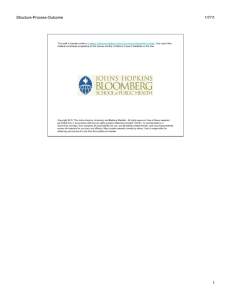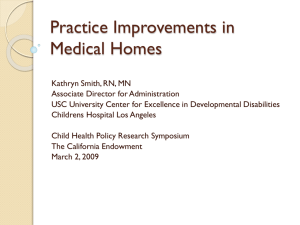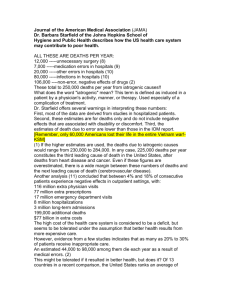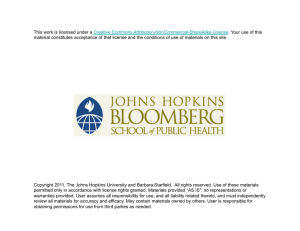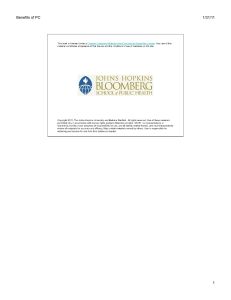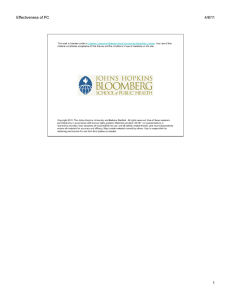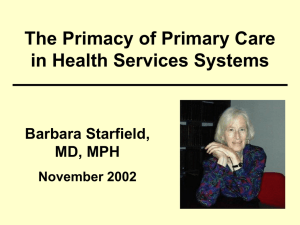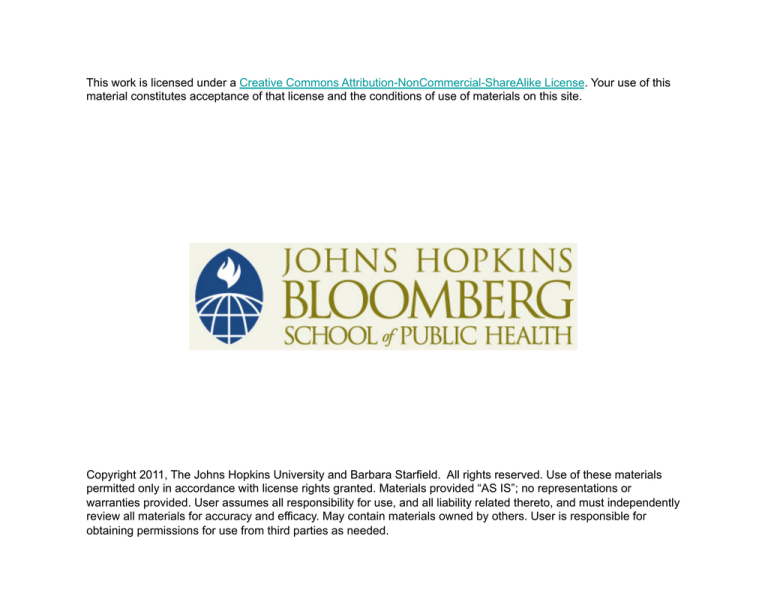
This work is licensed under a Creative Commons Attribution-NonCommercial-ShareAlike License. Your use of this
material constitutes acceptance of that license and the conditions of use of materials on this site.
Copyright 2011, The Johns Hopkins University and Barbara Starfield. All rights reserved. Use of these materials
permitted only in accordance with license rights granted. Materials provided “AS IS”; no representations or
warranties provided. User assumes all responsibility for use, and all liability related thereto, and must independently
review all materials for accuracy and efficacy. May contain materials owned by others. User is responsible for
obtaining permissions for use from third parties as needed.
Equity in Health
and Health Services
Barbara Starfield, MD, MPH
Primary Care Course
(Based on Cape Town, South Africa, 2007;
and Barcelona, Spain, 2009)
This presentation first provides a
definition of equity that is amenable to
measurement of ill health. It then
discusses major findings concerning
influences on equity in health, findings
from research on achievement of equity
in health in various countries, and
indicators of equity for future studies of
equity in health.
Starfield 02/11
PCB 7471
Equity in health is the absence
of systematic and potentially
remediable differences in one
or more aspects of health
across population groups
defined geographically,
demographically, or socially.
Source: www.iseqh.org
Starfield 07/07
EQ 5683 n
What Are “Systematic”
Differences?
“Systematic” means consistent
differences and is at the heart of the
distinction between inequalities across
individuals and inequities. What makes
differences “systematic” is a pattern of
influences that operate similarly to
create differences in health.
Starfield 04/05
EQ 6414
Equity Research Is Not the Same
as Social Determinants Research
• Social determinants research assumes an
individual model of health.
• Equity research assumes a population model of
health.
• Social determinants research generally neglects
types of influences on health that are other than
social.
• Equity research includes consideration of
political, policy, environmental, and health
systems effects, and their inter-relationships.
Starfield 03/04
EQ 6182
COMMUNITY
LEVEL
OCCUPATIONAL &
ENVIRONMENTAL
EXPOSURES
INDIVIDUAL
LEVEL
Social Influences on the
Health of Individuals
PHYSIOLOGICAL
STATE
MATERIAL
RESOURCES
SOCIODEMOGRAPHIC
CHARACTERISTICS
DEVELOPMENTAL
HEALTH
DISADVANTAGE
WEALTH: LEVEL &
DISTRIBUTION
POLITICAL
AND
POLICY
CONTEXT
SOCIAL
RESOURCES
POWER
RELATIONSHIPS
HEALTH*
BEHAVIORS
BEHAVIORAL &
CULTURAL
CHARACTERISTICS
CHRONIC
STRESS
HEALTH SYSTEM
CHARACTERISTICS
HEALTH SERVICES
RECEIVED
Shading represents degree to which characteristics are measured at the ecological
level (lighter color) or at the individual level aggregated to community.
GENETIC &
BIOLOGICAL
CHARACTERISTICS
*“Health” has two aspects: occurrence
(incidence) and intensity (severity).
Starfield 07/07
IH 6784 n
Characteristics of Social
Influences on Health
• They are interactive. Mechanisms of effect
cannot be specified, except theoretically, and
may differ from one population to another.
• Their relative frequency varies from one
population to another so that relative risk, but
not attributable risk, is the focus of attention.
Starfield 03/05
IH 6374
Life Course Influences on
Health
1. Early influences
– On growth and development, e.g., manifested in intrauterine
growth retardation, short stature, neonatal mortality, coronary
artery disease
– On infections and their sequelae, e.g., chronic respiratory
disease, rheumatic heart disease, gastric cancer, hemorrhagic
stroke, hypertension
2. Later influences
– Interactions of sociodemographic (i.e., age) characteristics and
socioeconomic status, and other “social” determinants (e.g.,
almost all diseases)
– Preventive health services (e.g., immunizations, screening for
early detection)
Sources: Galobardes et al, Epidemiol Rev 2004; 26:7-21. Lynch
& Davey-Smith, Annu Rev Public Health 2005; 26:1-35.
Starfield 07/07
IH 6376 n
Generalizations from Equity Research
Variability in health across geographic areas is
greatest among the lower social classes.
The level of geographic aggregation influences the
nature and extent of inequities.
The weakest association between income and health
is in old age. Social advantage is damaging at any
stage in life, but is especially harmful when
experienced early in life.
The effects of social class appear to be cumulative
over the life course.
Sources: Regidor et al, BMJ 1997; 315:1130-5. Judge & Paterson. Poverty, Income
Inequality and Health. Treasury of New Zealand, 2001. Benzeval et al. Income and
health over the life course: evidence and policy implications. In: Graham.
Understanding Health Inequalities. Open University Press, 2000. Power et al, Am J
Public Health 2005; 95:1396-1402.
Starfield 08/05
EQ 6187
Generalizations from Equity Research
People in lower social strata have not only more
illnesses, but also more comorbidity.
Differences in health across the social strata are
greater for severity than for occurrence of illness.
Sources: O'Donnell & Propper, J Health Econ 1991; 10:1-19. van Doorslaer
et al, Equity in the Finance and Delivery of Health Care: An International
Perspective, Oxford U. Press, 1993. Gwatkin. Lancet 2003; 361:540-1.
Starfield, Future Child 1992; 2:25-39.
Starfield 04/07
EQ 6189
Generalizations from Equity Research
Socioeconomic differences in disability-free life
expectancy are more pronounced than
differences in life expectancy.
Mortality rates are higher in lower SES for
almost all causes.
The contributions of specific causes to
differences in total mortality varies between
countries.
Source: Nusselder et al, Am J Public Health 2005; 95:2035-41.
Starfield 03/06
EQ 6557
Self-Rated Health and Individual Household Income
Starfield 05/99
EQ 5420 n
Errors of Commission: Birth Trauma Injury per
1,000 Live Births by Area Income, 2001
Source: AHRQ. 2004 National Healthcare
Disparities Report. Rockville, MD: AHRQ 2004.
Starfield 03/05
QEC 6402 n
Errors of Commission: Birth Trauma Injury per
1,000 Live Births by Race/Ethnicity, 2001
Source: AHRQ. 2004 National Healthcare
Disparities Report. Rockville, MD: AHRQ 2004.
Starfield 03/05
QEC 6401 n
Health services exert their effect
primarily on equity in progression of
illness and case-fatality rates.
Occurrence of illness is primarily
affected by other types of influences.
Mortality rates and life expectancy
are influenced by both, so that it is
more difficult to sort out mechanisms
of effect.
Starfield 08/06
IH 6604
Generalizations from Equity Research
Disadvantaged populations do not do better
living in advantaged areas (US data).
Wealthier people living in disadvantaged areas
have compromised ACCESS to health services
and consequent poorer health potential (US
data).
Sources: Winkleby et al, Am J Public Health 2006; 96:2145-53; Weich et al,
Br J Psychiatry 2001; 178:222-7. Subramanian et al, Soc Sci Med 2001;
53:9-19.
Starfield 04/07
EQ 6188
Generalizations from Equity Research
Different types of inequity are related.
Gender
Quintile
LE@birth
Yrs/% differ
Male
Female
5--poorest
73.1
80.7
7.6
9.4%
Male
Female
4
75.9
81.8
5.9
7.8%
Male
Female
3
76.7
82.5
5.8
7.0%
Male
Female
2
77.2
82.1
4.9
6.0%
Male
Female
1--richest
78.1
82.3
4.2
5.1%
Canadian data 1996
Starfield 03/04
EQ 6186 n
Hypothesized Influence
on Equity in Health
INCOME INEQUALTY
Little effect
Large effect
High “stress”
Smoking
Ischemic heart disease
Lung cancer
(Finland, Denmark)
Suicide
Homicide
(US)
Low material/social
supports, including
primary care
Other cancers
Stroke
Postneonatal mortality
Infant mortality
Low birth weight
Child survival
(US)
Starfield 04/04
EQ 6224
Improving average health, i.e., population-wide
rates of morbidity and mortality, is often
associated with increasing inequities, because
new and effective interventions often reach the
more advantaged first, thus increasing the
variability within the population. Also, influences
with high relative risk of poor health are not
necessarily appropriate targets for equityfocused interventions, as their frequency in the
subpopulations may be low and hence not
contribute much to reductions in inequity
overall.
Source: Victora et al, Lancet 2000; 356:1093-8.
Starfield 05/06
EQ 6582
Examples of How Average Mortality
Ratios Conceal Meaningful Differences
between Poor and Rich Populations
Better average
health (lower
mortality rate)
Worse average
health (higher
mortality rate)
Gap worse
Peru
Mean IMR: 49.9
Poor: 78.3
Rich: 19.5
Gap better
Uzbekistan
Mean IMR: 43.5
Poor: 49.5
Rich: 46.8
Mozambique
Mean IMR: 147.4
Poor: 187.7
Rich: 94.7
Haiti
Mean IMR: 87.1
Poor: 93.7
Rich: 74.3
IMR = infant mortality rate
Source: Tugwell et al, Lancet 2006; 328:1128-30.
Starfield 03/06
EQ 6559 n
The “determinants” of
health inequity are not only
“social”; they are “societal,”
involving all aspects of
society.
Starfield 04/05
IH 6418
In order to develop strategies to improve
equity in health, it is necessary to have a clear
picture of the various influences on health and
their interactions. Conventional models of
“determinants of health” (even those
characterized as “population health” models)
are more oriented to determinants of health in
individuals than populations. In reality, there
need to be two models of health: one directed
at understanding influences on individual
health and one directed at understanding
influences on population health.
Starfield 04/05
IH 6423
Societal Influences on Population Health and Equity
COMMUNITY CONTEXT
notes continued on IH 6891 bn
ENVIRONMENTAL
CHARACTERISTICS
POLICY CONTEXT
OCCUPATIONAL &
ENVIRONMENTAL
POLICY
POLITICAL
CONTEXT
SOCIAL
POLICY
EQUITY IN
HEALTH*
WEALTH: LEVEL &
DISTRIBUTION
POWER/STATUS
RELATIONSHIPS
HISTORICAL
HEALTH
DISADVANTAGE
RATES OF DISCOMFORT
AND DISEASE
ECONOMIC
POLICY
BEHAVIORAL &
CULTURAL
CHARACTERISTICS
RATES OF DISABILITY
AND DEATH
HEALTH
POLICY
HEALTH SYSTEM
CHARACTERISTICS
Dashed lines indicate the existence of pathways through individual-level
characteristics that most proximally influence health.
Shading represents degree to which characteristics are measured at the ecological
level (lighter color) or at the individual level aggregated to community.
DEMOGRAPHIC
STRUCTURE
*“Health” has two aspects: occurrence
(incidence) and intensity (severity).
Starfield 01/08
IH 6891 an
Societal Influences on Population Health and Equity (continued)
COMMUNITY CONTEXT
notes continued from IH 6891 an
ENVIRONMENTAL
CHARACTERISTICS
POLICY CONTEXT
OCCUPATIONAL &
ENVIRONMENTAL
POLICY
POLITICAL
CONTEXT
SOCIAL
POLICY
EQUITY IN
HEALTH*
WEALTH: LEVEL &
DISTRIBUTION
POWER/STATUS
RELATIONSHIPS
HISTORICAL
HEALTH
DISADVANTAGE
RATES OF DISCOMFORT
AND DISEASE
ECONOMIC
POLICY
BEHAVIORAL &
CULTURAL
CHARACTERISTICS
RATES OF DISABILITY
AND DEATH
HEALTH
POLICY
HEALTH SYSTEM
CHARACTERISTICS
Dashed lines indicate the existence of pathways through individual-level
characteristics that most proximally influence health.
Shading represents degree to which characteristics are measured at the ecological
level (lighter color) or at the individual level aggregated to community.
DEMOGRAPHIC
STRUCTURE
*“Health” has two aspects: occurrence
(incidence) and intensity (severity).
Starfield 01/08
IH 6891 bn
Conceptual Framework for Globalization and Health
Driving forces, facilitating factors, and constraints
Globalization
World markets
Population
level health
influences
Health
related
sectors
Individual health risks
National economy,
politics, and
society
Household economy
Health care system
Health of population/distribution
of health within population
Source: adapted from Woodward et al, Bull World Health Organ 2001; 79:875-81.
Starfield 07/07
GH 6767 n
Manifestations of Equity in Health Financing
(WHR 2000, Chapters 2 and 5)
• Low cost sharing at point of service
• Equal minimum benefit packages
• Pooling of resources, e.g., community
rating
• Regulation to assure universal
inclusion in pools
Starfield 01/02
EQ 5793
Manifestations of Equity in Health Financing
(continued)
(WHR 2000, Chapters 2 and 5)
• Large purchasing units
• Combination of payment mechanisms
to achieve good health care practices
• Global budgets rather than line-item
budgets
Starfield 01/02
EQ 5794
The World Health Report 2000 ranked
countries on equity of financing. Their
measure used a ratio of spending on health
divided by household expenditures except
for food, which assumes that all households
should spend the same proportion of their
non-food dollars on health services.
This measure is not consistent with WHO’s
own discussion of fairness in financing.
Starfield 01/02
EQ 5792
Health System Influences on
Health
• Public expenditures on health1, 2, 3
• Method of healthcare financing,
supply of physicians
• Orientation of health system4, 5
Sources: 1Navarro & Shi, Soc Sci Med 2001; 52:481-91. 2Or. Exploring the
Effects of Health Care on Mortality across OECD Countries. OECD, 2001.
3Houweling et al, Int J Epidemiol 2005; 34:1257-65. 4Starfield et al, Milbank Q
2005; 83:457-502. 5Mackenbach, Int J Health Serv 2003; 33:523-41.
Starfield 05/06
IH 6579
Countries that have better
average health status tend to
have less inequality in health
status.
Source: Joumard et al, Health Care Systems: Efficiency and Institutions.
OECD Economics Department Working Paper No. 769. Organization for
Economic Cooperation and Development, 2010.
Starfield 08/10
EQ 7403
System factors and health
policy are very important.
Primary care-oriented
countries rank higher on
features critical to equity.
Starfield 06/05
EQ 6439
System Features Important to Primary Health Care
Resource
Allocation Progressive
Cost
Compre(Score)
Financing* Sharing hensiveness
Belgium
France
Germany
US
0
0
0
0
0
0
1
0**
0
0
2
0
0
0
0
0
Australia
Canada
Japan
Sweden
1
1
1
2
2
2
2
2
2
2
1
1
2
2
1
1
Denmark
Finland
Netherlands
Spain
UK
2
2
2
2
2
2
2
0
2
2
2
1
2
2
2
2
2
2
1
2
Sources: Starfield. Primary Care: Balancing Health Needs, Services, and
Technology. Oxford U. Press, 1998. van Doorslaer et al. Equity in the Finance and
Delivery of Health Care: An International Perspective. Oxford U. Press, 1993.
*0=all regressive
1=mixed
2=all progressive
**except Medicaid
Starfield 11/06
EQ 5599 n
For-profit and Non-profit Primary
Care in New Zealand: Financial
and Cultural Barriers to Access
For-profit
Patient charges
Maori staff
Pacific staff
Non-profit
More by up to
(p<0.001)
a factor of 10
0.4
4.3 (p<0.001)
0.1
1.2 (p<0.001)
Source: Crampton et al, Int J Health Serv 2005; 35: 465-78.
Starfield 07/03
EQ 6061 n
Equity Effect of For-profit and
Non-profit Primary Care in New
Zealand: Management and Quality
Community needs
assessment
Written policy on
complaints
Written policy on
quality management
Source: Crampton et al, Int J Health Serv 2005; 35: 465-78.
For-profit
Non-profit
12%
41% (p<0.001)
48%
88% (p<0.001)
23%
75% (p<0.001)
Starfield 10/03
EQ 6062 n
For-profit and Non-profit Primary
Care in New Zealand:
Sociodemographic Characteristics
For-profit Non-profit
Maori or Pacific
Most deprived quintile
Source: Crampton et al, Int J Health Serv 2005; 35: 465-78.
15%
17%
60%
53%
Starfield 07/03
EQ 6063 n
Global Health Chart
Source: Karolinska Institute: www.whc.ki.se/index.php. All Rights Reserved.
Starfield 09/04
IC 5644 n
Share of Public Spending on Health among
Countries with Similar GNP per Capita But Very
Disparate Child Survival (to Age 5) Rates, 1995
Ratio*: percent of expenditures for health from the government to
poorest 20% vs. richest 20% of population
High child survival
Low child survival
Additional children
lost per 1000
Sri Lanka
1.1
Ivory Coast
0.3
150
Malaysia
2.6
Brazil
0.4
45
Costa Rica
2.1
South Africa
0.9
55
Jamaica
3.3
Ecuador
0.2
25
Nicaragua
1.0
India
0.3
50
Egypt
0.6
Ivory Coast
0.3
100
*Ratios of one or more signify a greater share of government expenditures
to poorest segment of population.
Sources: Calculated from Karolinska Institute, Global health chart, www.whc.ki.se/index.php. Victora
et al, Lancet 2003; 362:233-241. Castro-Leal et al, Bull World Health Organ 2000; 78:66-74. Carr.
Improving the Health of the World's Poorest People. Population Health Bureau, 2004.
Starfield 09/04
IC 6234 n
In 7 African countries
• The highest 1/5 of the population receives
well over twice as much financial benefit
from overall government health spending
(30% vs 12%).
• For primary care, the poor/rich benefit ratio
is much lower (23% vs 15%).
“From an equity perspective, the move
toward primary care represents a clear step
in the right direction.”
Source: Gwatkin, Int J Epidemiol 2001; 30:720-3, based on
Castro-Leal et al, Bull World Health Organ 2000; 78:66-74.
Starfield 03/04
IC 5751
Horizontal Inequity Indices for Specialist Care Use in 17
Countries, 2000 or Nearest Available Year
Note: Specialist care is inequitable (in this case, favoring high income groups) if the 95% confidence limit is significantly different
from zero. This is so for all countries, except the United Kingdom, the Netherlands, and Norway.
Sources: de Looper & Lafortune, OECD Health Working Paper No. 43 (
http://www.olis.oecd.org/olis/2009doc.nsf/LinkTo/NT00000DE2/$FILE/JT03260782.PDF).
van Doorslaer & Masseria, OECD Health Working Paper No. 14 (
http://fiordiliji.sourceoecd.org/vl=22046792/cl=47/nw=1/rpsv/cgi-bin/wppdf?file=5lgsjhvj7phb.pdf).
Starfield 05/09
EQ 7236 n
Primary Care Physicians and
Equity: Evidence-Based
Summary
In areas with low social inequity,
the additional effect of primary care
is small.
In areas of high social inequity, the
additional effect of primary care is
larger.
Sources: Vapattanawong et al, Lancet 2007; 369:850-5;
Starfield et al, Milbank Q 2005; 83:457-502.
Starfield 04/05
EQ 5628
Reductions in Inequality in Health by
Primary Care: Self-Reported Health,
60 US Communities, 1996
Percent reporting fair or poor health
• Areas with low income inequality (mostly homogeneous
high income areas)
– No effect of primary care resources*
• Areas with moderate income inequality
– 16% increase in areas with low primary care resources*
• Areas with high income inequality
– 33% increase in areas with low primary care resources
*compared with median # of primary care physicians to population ratios
Based on data in Shi et al, J Fam Pract 1999; 48:275-84.
Starfield 10/04
EQ 5552 n
Reductions* in Inequality in Health
by Primary Care: Stroke Mortality,
50 US States, 1990
Areas with low income inequality (mostly homogeneous high
income areas)
High primary care resources
Low primary care resources
1.3% decrease in mortality
2.3% increase in mortality
Areas with high income inequality
High primary care resources
Low primary care resources
2.3% decrease in mortality
1.1% increase in mortality
*compared with population mean
Based on data in Shi et al, J Fam Pract 1999; 48:275-84.
Starfield 09/04
EQ 5553 n
Reductions* in Inequality in Health
by Primary Care: Postneonatal
Mortality, 50 US States, 1990
Areas with low income inequality (mostly homogeneous high income
areas)
High primary care resources
Low primary care resources
0.8% decrease in mortality
1.9% increase in mortality
Areas with high income inequality
High primary care resources
Low primary care resources
17.1% decrease in mortality
6.9% increase in mortality
*compared with population mean
Based on data in Shi et al, J Fam Pract 1999; 48:275-84.
Starfield 09/04
EQ 5554 n
Equity of Access: Country Rankings
< average income > average income
8 items:
5 ranks*
U
K
Within country
(range 1-40)
11 19 25 26 39 15 28 24 25 29
Overall rank
(range 1-5)
1
2
3
4
5
Percentage
point
difference
1
2
4
3
5
*Lower rank number = better access.
Source: Schoen et al, Health Aff 2004; W4:487-503.
A
U
S
C
A
N
N
Z
U
S
U
K
1
A
U
S
4
C
A
N
2
N
Z
3
U
S
5
Starfield 05/05
EQ 6221 n
Percentage Reduction in Under-5
Mortality: Thailand, 1990-2000
Poorest quintile (1) 44
(2) 41
(3) 22
(4) 23
Richest quintile (5) 13
Rate ratio (Q1/Q5) 55
Absolute difference 61
(Q1-Q5)
Source: Vapattanawong et al, Lancet 2007; 369:850-5.
Policy changes:
1989 At least one primary care health
center for each rural village
1993 Government medical welfare
scheme: all children less than 12,
elderly, disabled
2001 Entire adult population insured
Activities of Rural Doctors’ Society
Starfield 07/07
WC 6700 n
Inappropriate Investigations Prescribed for
Simulated Patients Presenting with a Minor
Stomach Complaint, Thailanda,b
Starfield 05/09
WC 7125 n
A comparison of age-adjusted survival from breast
cancer showed that
• Low SES is strongly associated with decreased
survival in US, but not Canada.
• The survival advantage in Canada is present in
low income areas only.
• The survival advantage in Canada is much
larger at ages under 65.
• The Canadian survival advantage is larger for
later stage diagnosis. That is, there is almost
certainly a medical care benefit to equity in the
Canadian context.
Source: Gorey, Int J Epidemiol 2009;38:1543-51 .
Starfield 08/09
IC 7158 n
Studies in other developing and middle income
countries also show benefit from primary care
reform.
• In Bolivia, reform in deprived areas lowered
under-5 mortality rates compared with
comparison areas.
• In Costa Rica, primary care reforms in the 1990s
decreased infant mortality and increased life
expectancy to rates comparable to those in
industrialized countries.
• In Mexico, improvements in primary care
practices reduced child mortality in socially
deprived areas.
Sources: Perry et al, Health Policy Plann 1998; 13:140-51; Reyes et al, Health Policy Plann 1997; 12:214-23;
Rosero-Bixby, Rev Panam Salud Publica 2004; 15:94-103; Rosero-Bixby, Soc Sci Med 2004; 58:1271-84.
Starfield 08/05
WC 6451
Perinatal Indicators
• Low rates of:
– undesired pregnancies
– perinatal complications
– pregnancy-related complications
– postneonatal mortality
– neonatal death from tetanus
– maternal mortality
Starfield 07/07
EQ 5235
Infancy Indicators
• Low birth weight (specialty care)
• Postneonatal mortality (primary
care)
• Breastfeeding*
• Tetanus toxoid*
• HIV/AIDS
*especially developing countries
Source: Jones et al, Lancet 2003; 362:65-71.
Starfield 07/07
EQ 5645
Childhood Indicators
• Immunizations (primary care)
• Child survival to age 5
– From external causes (public health)
– From “medical” causes (primary and
specialty care)
• Malaria protection and treatment*
• Management of gastroenteritis*
all primary
care
• HIV/AIDS*
• Treatment of respiratory infection*
*especially developing countries
Source: Jones et al, Lancet 2003; 362:65-71.
Starfield 07/07
EQ 5646
Teenage Period Indicators
(all primary care)
• Preventive and health-promoting
behaviors, especially those not related
to specific diseases
• Adverse effects of medications
• Rates of attempted suicide
• Emergency visits for asthma
• Hospitalizations for ambulatory care
sensitive conditions
Starfield 07/07
EQ 5647
Early and Middle Adulthood Indicators
(all primary care)
•
•
•
•
•
•
•
•
•
Low birth weight of offspring
Breastfeeding, seat belts, physical activity
Low smoking rates
Asthma death rates
Hypertension and cerebrovascular disease: premature
mortality and age-adjusted death rates
Hospitalizations for ambulatory care sensitive conditions
Suicide rates
Symptoms of peptic ulcers
Adverse effects of medications
Starfield 07/07
EQ 5648
Elucidation of pathways is necessary to devise
appropriate interventions.1
Knowing about the pathways to poor health and
inequity in health is important. Yet, most
“models” of influences on health do not
consider pathways and interactions within the
pathways that may operate differently in
different populations. Even newer
conceptualizations² that focus specifically on
societal influences do not explicitly recognize
pathways and interactions.
Sources: 1Exworthy et al, Milbank Q 2006; 84:75-109. 2Etches
et al, Annu Rev Public Health 2006; 27:29-55.
Starfield 05/06
EQ 6580
Specific disease-oriented
interventions will not change
inequities in health because
the socially disadvantaged
are more vulnerable to
almost all diseases.
Source: Starfield B, Birn A-E, J Epidemiol Community Health 2007; 61:1038-41.
Starfield 04/07
EQ 6587
Universal social programs are
critical to reducing inequities in
health, although they may have to
be tailored to the special needs of
particular disadvantaged groups.
A health system oriented around
a strong primary care base is one
example of such a strategy.
Sources: Starfield B, Birn A-E, J Epidemiol Community Health 2007;
61:1038-41. Jones et al, Int J Health Serv 2006; 36:425-42. WHO: The
World Health Report 2008: Primary Health Care in the 21st Century.
Starfield 04/07
EQ 6717


